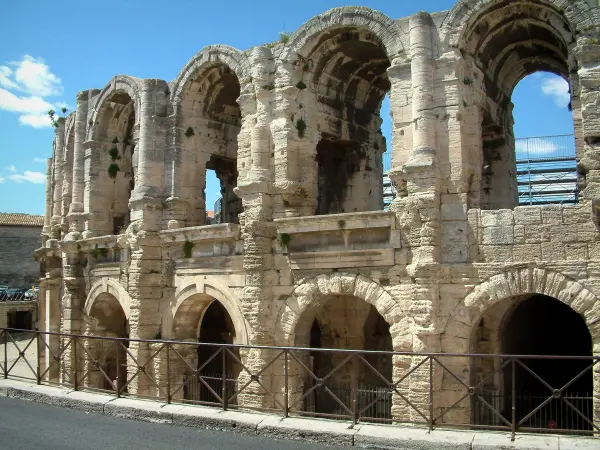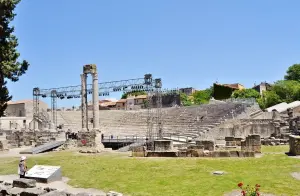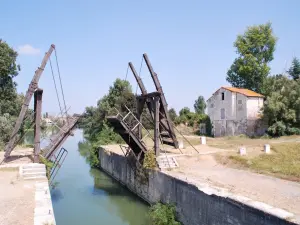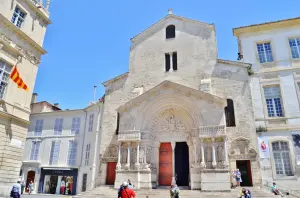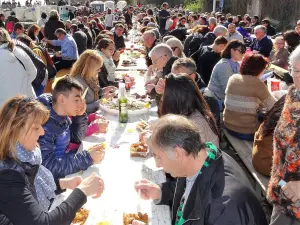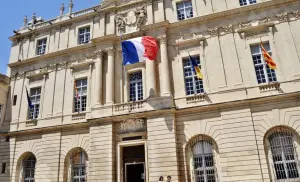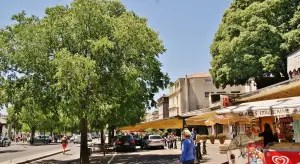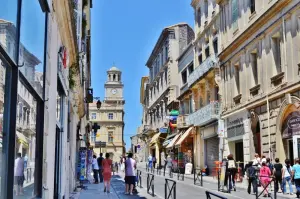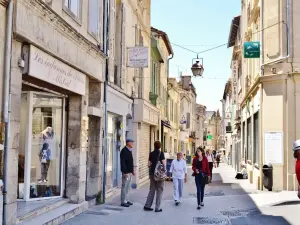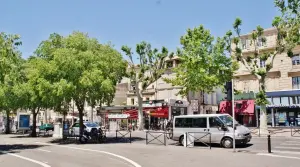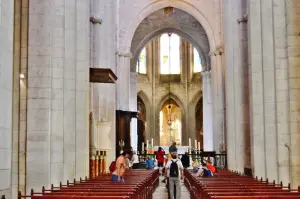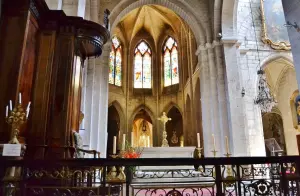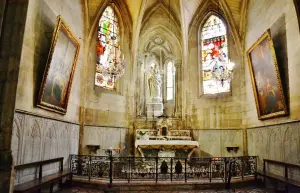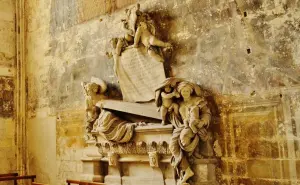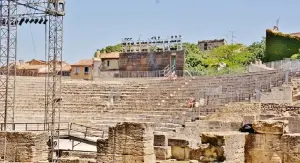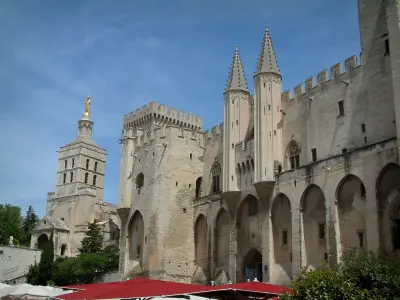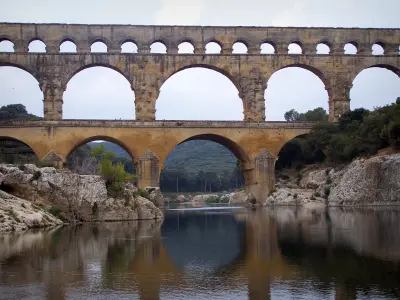City of Art and History, Arles is famous for its ancient and Romanesque remains. The city indeed boasts several monuments inscribed on the UNESCO World Heritage List: Its Roman amphitheatre (Les Arènes); its ancient theatre; the Alyscamps, an alley lined by sarcophaguses; the Cryptoportiques, a network of underground galleries supporting the ancient forum; The Constantin's Thermal baths, the portal and cloister of the Church of Saintt-Trophime. The Romanesque church of Saint-Trophime constitutes an important stopping point on the Way of St James (Santiago de Compostela pilgrim route).
Arles offers a wide choice of museums, such as the museum of Ancient Arles and Provence, the Museon Arlaten (traditional art and Provençal culture), the Réattu museum (contemporary art), and the Camargue museum.
Numerous places in the city, such as the garden of the hospital where Van Gogh stayed when he cut off his ear (now Espace Van Gogh, a cultural centre), the forum square, the quaysides of the Rhone river and Les Arènes, were immortalised in famous paintings by Van Gogh during his stay in Arles. A full Van Gogh circuit is offered in the city, with panels representing the works of the artist at the various places where he was inspired.
Situated near the Camargue, the city has preserved its traditions: the Gardians festival (herdsmen's festival), the Costume festival (traditional dress festival), and bullfighting events in Les Arènes: the Feria de Pâques and Feria du Riz. Capital of photography, Arles organises an international photography gathering, a famous event featuring exhibitions, parties and conferences dedicated to this art.
Arles, France's largest municipality in terms of surface area, is located in Provence-Alpes-Côte d'Azur, in the heart of the Bouches-du-Rhône department. Important tourist town, it is located about thirty kilometers from Nîmes, in the historic Camargue.
Labeled City of Art and History, Arles was in the Iron Age one of the main cities of the country before becoming an important site of Roman Gaul under Julius Caesar. Annexed to France from the sixteenth century, the town has continued to evolve over the centuries. A viticultural city, Arles is today mainly turned towards tourism and photography, revealing to its visitors an important historical and ancient heritage, part of which is classified as a UNESCO World Heritage Site.
Animated, the Camargue city is also appreciated for its intense and very developed cultural life which proposes events throughout the year. Attached to its Provençal and Camargue traditions, the town of Arles continues to preserve some old productions like the santons for Christmas cribs. Some AOCs testify to the richness of its gastronomy, like the bull of Camargue appreciated in the gardianes or the olive oil of the Baux de Provence and the rice of Camargue.
Spearhead of Arlesian tourism, the Roman heritage and Romanesque of the city is fully inscribed on the UNESCO World Heritage List. Eight monuments are thus concerned, starting with the Roman amphitheater. Built around 80 BC, it is also classified as an historic monument. Completely restored, it is the most visited monument of the town and still hosts many shows. Dating back to the same period, the Roman Theater, listed as a Historical Monument, can still be visited. There are remains of the sealing of the swan altar in the heart of the orchestra or two columns reminiscent of the hundred others who decorated the scene. Like the amphitheater, it is now used as a venue for shows.
Roman baths of the fourth century BC, the baths of Constantine take place on the banks of the Rhone. Classified as Historical Monuments, they still present the caldarium and its swimming pools, as well as parts not yet searched today. Remains of the ancient Roman forum survive in the city with the present of classified cryptoportiques.
Romanesque building, the Church of St. Trophime is also an ancient relic. Classified as a Historic Monument and World Heritage, it reveals an architecture dating back to the twelfth century, taking place on the remains of a basilica of the fifth century. Gothic elements were then added, especially at the bedside. Inside, you can appreciate Aubusson tapestries from the 17th century classified as Historical Monuments and representing elements of the life of the Virgin. The ramparts of the Roman castrum and the Roman exedra are also part of this heritage.
Considered one of the oldest religious buildings of Arles, Saint Cesaire Abbey is a former women's monastery founded in the 6th century. The building which also reveals a paleochristian basilica is classified as an historic monument.
Other important churches are found in Arles, such as the Major Monument and the UNESCO. Dedicated to an ancient Romanesque temple during the fifth century, it was modified in the twelfth century before being erected as a collegiate church in the mid-sixteenth century. It reveals beautiful elements of Romanesque style, as well as a Louis XIII style facade. Also listed, the Saint-Julien church was rebuilt in the seventeenth century and serves as a venue for shows and exhibitions. Gothic style, the school of the Dominicans dates from the late fifteenth century and is now decommissioned. Classified, it can still be visited today.
Several museums of great interest take place at Arles, like the Réattu museum. Housed in the former grand hospital priory of the seventeenth century, the site unveils collections of the Arlesian painter of the same name, as well as drawings by Pablo Picasso. The museum is also dedicated to photography as well as architecture.
Archaeological museum, the departmental museum Arles Antique unveils all the archaeological collections discovered at Arles.
Dedicated to the painter of the same name, the Van Gogh Foundation offers works by the Dutch painter, as well as contemporary paintings.
An ethnographic center, the Museon Arlaten was created in the 19th century by Frédéric Mistral. In renovation until 2019, he unveiled his collections in other sites of the city.
Classified or registered with the Historical Monuments, several mansions of the Renaissance or the classic period take place in the city. For example, the hotel Courtois de Langlade, today seat of the sub-prefecture, the Rotunda which now serves as a Protestant temple or the glassworks of Trinquetaille eighteenth century.
Five nature reserves also take place on the territory of Arles, those of Camargue, Cossouls of Crau, Marshes of Vigueirat, L'Illon and Tour du Valat.
The market is held on Wednesday and Saturday mornings and is one of the largest in Provence.
The traditional Oursinades are held every year around March 23, close to the famous Van-Gogh bridge and along the Arles canal in Bouc. Festive day, tasting of sea urchins and white wines from the Arles region.
Two ferias take place at Arles, during the Easter weekend and the second in September.
On May 1, the feast of the guardians is the scene of the election of the queen of Arles every three years.
At the beginning of May, the city hosts the international festival of nude photography.
Jazz in Arles takes place in mid-May.
At the beginning of July, the international photography meetings of Arles, which celebrate their 50th anniversary in 2019, take place, as well as Voies off, the off-photo festival (until the end of September).
Mid-July, the Festival des Suds offers a week of music.
At the end of August, discover Arelate, the Roman days of Arles and the Peplum festival (in the ancient theatre).
In September, make way for the Horse and Gourmet Camargue Festival as well as the Rice Harvest Festival.
Mid-September, the Arles ceramics market: 33 potters of all techniques will be present: sculpture, stoneware, raku, glazed clay, tableware, jewelry, porcelain, mixed clays... Many animations around the earth.
The Harp Festival is held at the end of October.
From the end of November to the beginning of January, discover the santonniers' fair.
Funny Christmas in December unveils a craft market and entertainment.
The ornithological park of Pont de Gau, near Saintes-Maries-de-la-Mer, with nearly 1200 flamingos, an unforgettable pedestrian route.
The psychiatric hospital of Saint-Paul-de-Mausole near Saint-Rémy, where Van Gogh was interned, and where he painted many paintings.
The marsh of Vigueirat offers a discovery of nature on the edge of the Camargue.
The village of Les Baux-de-Provence and the sound and light show at the castle and the quarries of lights.
The Saintes-Maries-de-la-Mer, its fortified church and its pilgrimage of gypsies on May 24th.
Aigues-Mortes, former departure for the crusades, its fortified city, its salt marshes.
